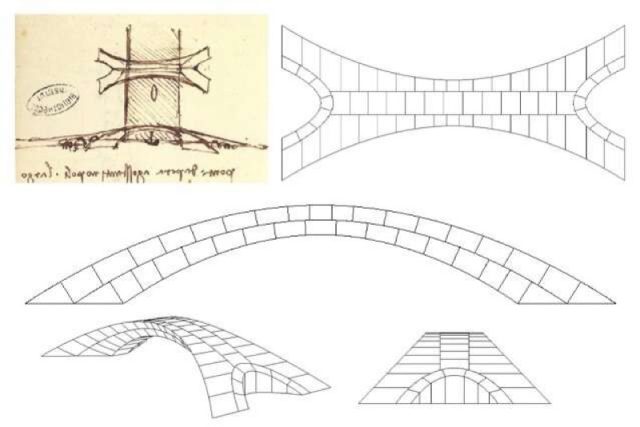
Pedestrians and bicyclists in Ås, Norway, use the Da Vinci Bridge to cross the city's E-18 highway, a laminated-wood structure based on an early 16th-century sketch by Leonardo da Vinci. Had Leonardo's bridge ever been built, it would have been the longest bridge span of its time. But would his original design, given the materials available at the time, have been stable enough to support the necessary loads and withstand seismic tremors? According to a team of researchers at MIT, who built a detailed scale model to test that hypothesis, the answer is yes. The group presented its results last week at a conference in Barcelona, Spain.
The MIT group is led by John Ochsendorf, who has been studying ancient architecture and construction for many years and has a particular interest in domes and arches. Several years ago, he adapted particle spring modeling—the same tool often used to recreate the movement of fabrics and hair in CGI animation (like the movement of Yoda's cloak in his battle with Darth Sidious in Revenge of the Sith)—to model those architectural features. Ochsendorf's version reversed the model so that instead of modeling tension, it modeled compression. The software program featured virtual "masses" at key "nodes" connected by virtual "springs," which bounce around until they find equilibrium, indicating that the design can support the requisite loads.
Compression is the key to any stable arch. "An arch consists of two weaknesses which, leaning one against the other, make a strength," Leonardo once observed. He was describing a delicate balance of opposing forces based on an inversion of a curved geometric shape known as a catenary. Suspend a flexible chain from two points, and it will naturally come to rest in a state of pure tension. Invert that shape, and you have a state of pure compression. Robert Hooke phrased it best in the 17th century: "As hangs the flexible chain, so inverted stands the rigid arch." It's how Gothic architects, for example, were able to design and construct magnificent domes like the one topping the chapel vault at King's College, Cambridge.

Norway's pedestrian bridge is built with modern material (glued laminated timber, or glulam). In Leonardo's time, masonry was the preferred material. Masonry will break easily under tension, yet it can withstand huge compressive forces. So that was Leonardo's choice of material when he pitched his bridge design to the Ottoman ruler Sultan Bayezid II of Turkey in 1502. The sultan wanted a bridge to span a river estuary known as the Golden Horn to connect Constantinople (now Istanbul) to the neighboring town of Galata—a bridge span of about 919 feet (280 meters), roughly ten times longer than a typical bridge of that era, according to co-author Karly Bast, a graduate student at MIT.
Masonry bridges in that era were usually built with a series of semicircular arches, but a span as long as the sultan required would need to be bolstered by at least ten piers. That meant ships wouldn't be able to pass beneath it. Leonardo envisioned a bridge "as high as a building" with just a single arch, relying on pure compression for structural stability, without any additional fasteners or mortar to hold the stone together. Since the region was prone to earthquakes, Leonardo also incorporated abutments splaying outward on either side of the bridge to stabilize the structure against lateral motion.
To test Leonardo's bridge design, Ochsendorf, Bast, and co-author Michelle Xin (an undergraduate at MIT) pored over historical documents to glean as much information as possible about materials and construction methods common in the early 16th century, as well as the geologic conditions at the original proposed site for the bridge (the Golden Horn). They concluded the bridge would indeed have been made of stone, since wood or brick would not have been able to withstand the load of a such a long span.

The group first determined how best to slice up the shape of the bridge into individual blocks and then used a 3D printer to make 126 blocks to build a scale model, the better to recreate the complex geometry of Leonardo's original design. They used a scaffolding structure to support their bridge as it was being assembled, removing it once the keystone at the top of the arch was in place. And the structure was stable, just as Leonardo envisioned.
To test the resilience to seismic tremors, the MIT team mounted its model on two moveable platforms and then moved them away from each other the way a bridge's foundation might move in weak soil. And once again, Leonardo's design proved stable and resilient, adapting to the horizontal movement quite well until the movement between the platforms became so extreme that the structure collapsed.
Leonardo never got the commission to build his bridge for the sultan, which is a shame, because his design might have revolutionized bridge architecture much earlier. Alas, his design was lost for several centuries, until it was rediscovered in 1952. But a bridge was eventually built across the Golden Horn in 1845, made of wood, that lasted for 18 years. The Galata Bridge has been rebuilt several times since then, and its current incarnation boasts a center drawbridge—solving the problem of ship passage in a different way—with shops below and tram tracks above. I'm guessing Leonardo would approve.
reader comments
109